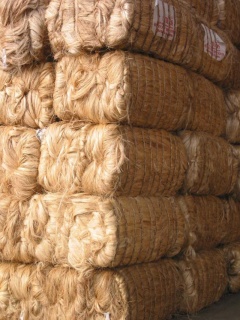Abaca
| Infobox on Abaca | |
|---|---|
| Example of Abaca |  |
| Facts | |
| Origin |
|
| Stowage factor (in m3/t) |
|
| Humidity / moisture | Relative humidity 55% Water content 5 - 10% Maximum equilibrium moisture content 55% |
| Oil content | - |
| Ventilation | Air exchange rate: 10-20 changes/hour (airing) |
| Risk factors | Hazard IMDG Class 4.1 (Flammable Solids) |
Abaca
Description
Strong vegetable fiber from a tree of the banana family, shipped in high-density bales mainly in freight containers. Used in the manufacture of specialty papers and, to a limited extend, cordage.
The plant is of great economic importance, being harvested for its fibre, once generally called Manila hemp, extracted from the trunk or pseudostem. On average, the plant grows about 12 feet (4 meters) tall. The fiber was originally used for making twines and ropes; now most abacá is pulped and used in a variety of specialized paper products including tea bags, filter paper and banknotes. It is classified as a hard fiber, along with coir, henequin and sisal.
It can be used to make handcrafts like bags, carpets, clothing and furniture. Abacá rope is very durable, flexible and resistant to salt water damage, allowing its use in hawsers, ship's lines and fishing nets. Abacá fiber was once used primarily for rope, but this application is now of minor significance. Lupis is the finest quality of abacá. Sinamay is woven chiefly from abacá.
Shipment/storage
Manila hemp behaves strongly hygroscopically (hygroscopicity). It must be protected from sea, rain and condensation water and also from high levels of relative humidity, if discoloration and mustiness are to be avoided.
Manila hemp may increase its water content to 30% without feeling damp. For this reason, moisture levels should be measured when a consignment is accepted. Moisture-damaged bales must not be accepted.
Water damaged fiber requires drying and reprocessing. It does not lose strength when wet with fresh water.
Risk factors
Since Manila hemp is highly oxygen-absorbent, a life-threatening shortage of oxygen may arise in the hold or container. Thus, before anybody enters the hold, it must be ventilated and, if necessary, a gas measurement carried out. The TLV for CO2 concentration is 0.49 vol.%.
If loosely packed and if in contact with grease, or oil, could be liable to spontaneous combustion.
Hazard: IMDG Class 4.1 (Flammable solid)











